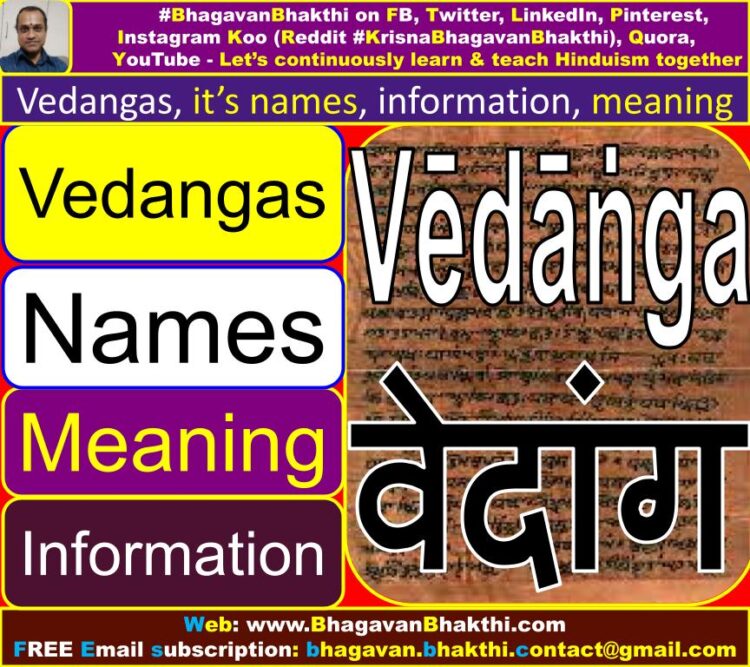What are Vedangas, different Vedangas names (information) (meaning) (importance) (significance)
Namaste friends, how are you doing today? Welcome to #BhagavanBhakthi website / blog.
Bhagavan Lord Sri Krishna (Vishnu) (Rama) blessings to you and your family!
In this website / blog, you will always learn about #Hinduism #Sanskrit language.
Also subscribe to my YouTube channel from this link #BhagavanBhakthi to view videos about #Hinduism #Sanskrit language.
Just before going to “What are Vedangas, different Vedangas names (information) (meaning) (importance) (significance)“, let us know a brief, basic and very important information.

Hindu texts (scriptures) (Granthas) (Holy books) (treatise) are the manuscripts which are vast ancient composition literature.
These are authenticatively associated to the diverse traditions within Sanatana Dharma (Hinduism).
These authentic texts (scriptures) (Granthas) (Holy books) (treatise) of Sanatana Dharma (Hinduism) were written by Lord Sri Vishnu himself.
And few of them were composed by other Rishis and Devatas (Demigods) as per instructions of Lord Sri Vishnu.
The Hindu texts (scriptures) (Granthas) (Holy books) (treatise) are divided into Shrutis (that can be heard) and Smritis (that can be recalled or remembered).
In this post (article), you can get the knowledge about the Vedangas, different Vedangas names with basic information and meaning.
Vedangas : In Sanskrit Vedangas is written as वेदाङ्ग (vēdāṅga). Whereas the meaning of the word Vedangas in Sanskrit means, “parts of the Vedas” or “limbs of the Vedas“.
The different types of Vedangas are as given below:
Shiksha (शिक्षा) (śikṣā), Chandas (छन्दस्) (chandas), Vyakarana (व्याकरण) (vyākaraṇa), Nirukta (निरुक्त) (nirukta), Jyotisha (ज्योतिष) (jyōtiṣa), and Kalpa (कल्प) (kalpa).
Basic meaning and information of Vedangas is as given below:
1. Shiksha : The first type of the Vedanga is called as Shiksha. Shiksha gives importance to ध्वनि शिक्षा (dhvani śikṣā), that is, phonetics, pronunciation.
This Vedanga deals with the letters of the Sanskrit alphabet, accent and rules of euphonic combination of words during a Vedic recitation.
2. Chandas : This type of Vedanga gives importance to the poetic meters, including those based on fixed number of syllables per verse.
The use of this Vedanga is about reading and reciting of the Vedic hymns. The Chandas discusses the number of syllables in texts and poems which is linked to meter.
This Chandas part is often referred to as the feet of the Veda Purusha (Lord Sri Vishnu).
3. Vyakarana : This deals with the grammar and linguistic analysis of the Sanskrit language to establish the exact form of words and sentences to properly express ideas.
Vyakarana is called the mouth of the Veda Purusha (Lord Sri Vishnu) and is also seen as crucial for understanding the Vedas.
4. Nirukta : Nirukta deals with the etymology of the Sanskrit language and also handles the explanation of words, especially those that are classical in nature and have ancient uses with unclear meaning.
This part of the Vedanka (Nirukta) is called as the ears of the Veda Purusha (Lord Sri Vishnu).
5. Jyotisha : Jyotisha is very important part of Vedangas which discusses about the right time for rituals with the help of position of nakshatras and astronomy.
Jyotisha is not about the teaching of astronomy, but the use of astronomy like to fix the appropriate time, day, etc. for the sacrifice(s).
Jyotisha is known as the eye of the Veda Purusha (Lord Sri Vishnu).
6. Kalpa : This deals with the ritualistic instructions. This field gives importance about the standardizing procedures for Vedic rituals.
For example the rites of passage rituals associated with major life events like birth, wedding and death in family.
Also, this Vedanga discusses about the personal conduct and proper duties of an individual in different stages of his life.
Kalpa is known as the arms of the Veda Purusha (Lord Sri Vishnu).
More information will be added to his post (article) on regular basis. Please visit again to know the updated information after some time.
To watch videos on #Hinduism #Sanskrit language, SUBSCRIBE to my YouTube channel from this below link:
#BhagavanBhakthi YouTube channel
To know more about “Vedas information, facts, significance, means, etc.“, please click the below link:
Vedas information, facts, significance, importance, meaning, etc.
Continue reading about “List of Hindu texts names (With basic information) (scriptures) (Granthas) (Holy Books) (treatise)” from these below links:
List of Hindu texts names – Part 1 of 4 (With basic information)
Dear friends, if you need any clarifications about this post, kindly let me know, I will definitely try to answer all of them.
Also your one LIKE, one COMMENT, One Share, one SUBSCRIPTION is highly important.
This will help to know the quality of this content and also it will be helpful to know if any improvements is required for the content.
If you feel this content is useful to you and has helped you to improve your knowledge, kindly share this with your well-wishers. Because “SHARING MEANS CARING”.
To receive FREE EMAIL SUBSCRIPTION about #BhagavanBhakthi, you can send an email to [email protected] from your email ID.
NAMASTE!
Sri Gurubhyo namaha
Om Sri Krishnaaya namaha
Sri Krishnaarpanamastu
Share in Social Media